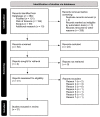Spinal Cord Injury and Complications Related to Neuraxial Anaesthesia Procedures: A Systematic Review
- PMID: 36902095
- PMCID: PMC10003521
- DOI: 10.3390/ijms24054665
Spinal Cord Injury and Complications Related to Neuraxial Anaesthesia Procedures: A Systematic Review
Abstract
The use of neuraxial procedures, such as spinal and epidural anaesthesia, has been linked to some possible complications. In addition, spinal cord injuries due to anaesthetic practice (Anaes-SCI) are rare events but remain a significant concern for many patients undergoing surgery. This systematic review aimed to identify high-risk patients summarise the causes, consequences, and management/recommendations of SCI due to neuraxial techniques in anaesthesia. A comprehensive search of the literature was conducted in accordance with Cochrane recommendations, and inclusion criteria were applied to identify relevant studies. From the 384 studies initially screened, 31 were critically appraised, and the data were extracted and analysed. The results of this review suggest that the main risk factors reported were extremes of age, obesity, and diabetes. Anaes-SCI was reported as a consequence of hematoma, trauma, abscess, ischemia, and infarction, among others. As a result, mainly motor deficits, sensory loss, and pain were reported. Many authors reported delayed treatments to resolve Anaes-SCI. Despite the potential complications, neuraxial techniques are still one of the best options for opioid-sparing pain prevention and management, reducing patients' morbidity, improving outcomes, reducing the length of hospital stay, and pain chronification, with a consequent economic benefit. The main findings of this review highlight the importance of careful patient management and close monitoring during neuraxial anaesthesia procedures to minimise the risk of spinal cord injury and complications.
Keywords: acute back pain; anaesthesia; analgesia; epidural anaesthesia; hematoma; motor deficit; neuraxial technique; paraplegia; sensorial deficit; spinal anaesthesia; spinal cord injury.
Conflict of interest statement
The authors declare no conflict of interest.
Figures
References
-
- Kotoda M., Mochizuki N., Matsuoka T., Kondoh D., Matsukawa T. Successful epidural anesthesia in a patient with an extremely shallow epidural space: A case report. Anaesth. Pain Intensive Care. 2018;22:224–226.
Publication types
MeSH terms
LinkOut - more resources
Full Text Sources
Medical
Research Materials


